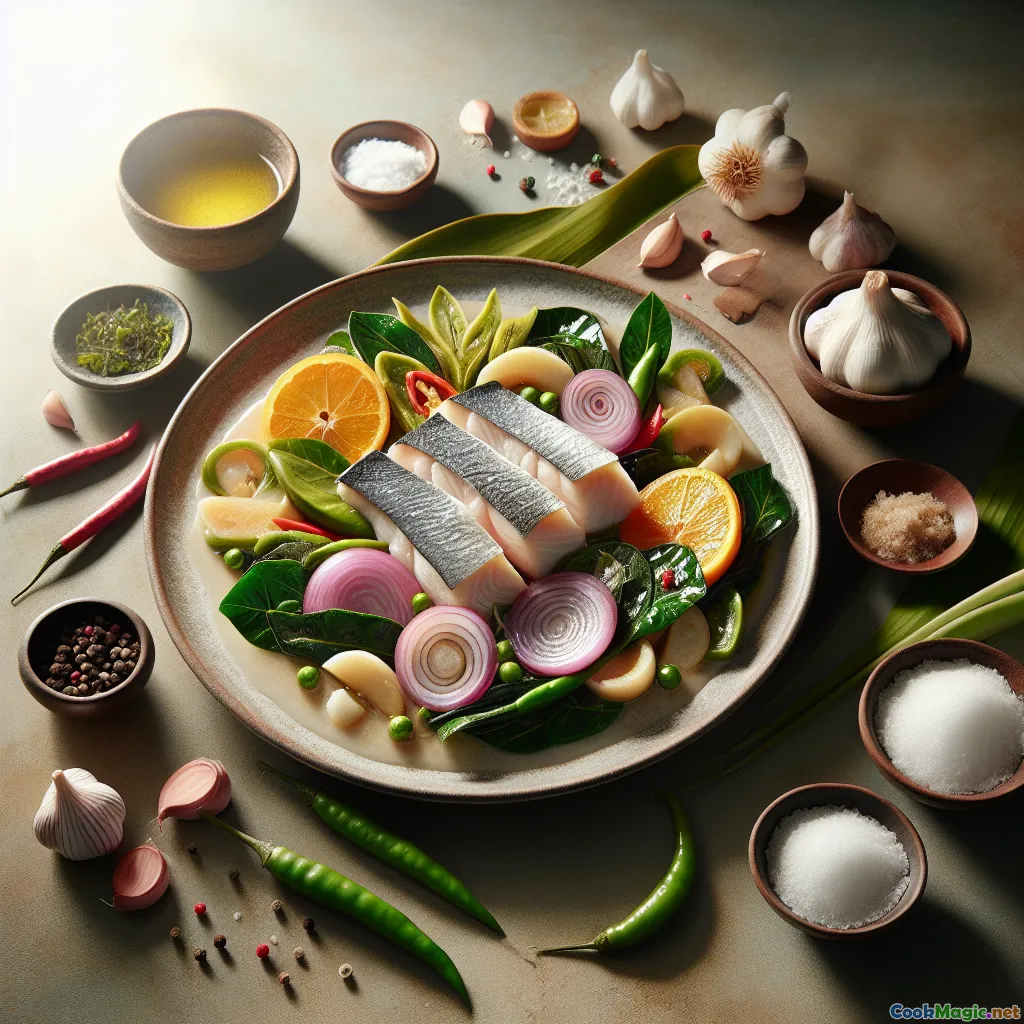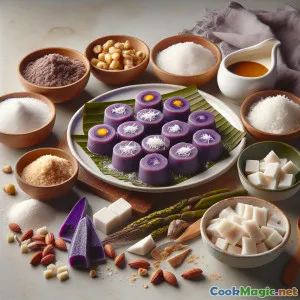
桑托尔牛奶鱼卤煮 – 桑托尔酸味炖煮
(Milkfish Paksiw with Santol Sour Stew)
(0 评论)食材
-
900 grams Bangus (milkfish),清洗干净并切成牛排状
(About 1 large fish; remove gills and innards to reduce bitterness)
-
500 grams Santol(棉花果)、去皮、去籽、切成薄片
(Choose ripe but firm; remove the fuzzy seed sacs carefully)
-
180 ml 甘蔗醋
(Adjust to taste; white vinegar works in a pinch)
-
400 ml 水
(Add more for a soupier stew)
-
6 cloves 大蒜,轻微拍碎
(Do not mince; keeps flavor mellow)
-
30 grams 姜,切成薄片
(About a 2-inch knob)
-
1 piece 红洋葱,切片
(Medium size)
-
2 pieces 长绿辣椒(siling pangsigang),整条或纵向切开
(Adds aroma and mild heat)
-
1 tsp 整粒黑胡椒粒
(Lightly crush for more peppery punch)
-
1.5 tsp 盐
(按口味调味)
-
1 tbsp 鱼露(patis)
(Use instead of or with soy for umami depth)
-
1 tbsp 酱油
(Optional; adds color and a different savory note)
-
1 tsp 红糖
(Balances sharp acidity if desired)
-
100 grams 芥菜叶或小白菜
(Rinse well; stems thinly sliced)
-
1 tbsp 食用油
(Only if pre-searing fish to firm it up)
-
1 sheet 香蕉叶
(Line the pot to prevent sticking and add aroma)
-
1 piece 小米辣椒(siling labuyo)
(For extra heat; keep whole to control spiciness)
(About 1 large fish; remove gills and innards to reduce bitterness)
(Choose ripe but firm; remove the fuzzy seed sacs carefully)
(Adjust to taste; white vinegar works in a pinch)
(Add more for a soupier stew)
(Do not mince; keeps flavor mellow)
(About a 2-inch knob)
(Medium size)
(Adds aroma and mild heat)
(Lightly crush for more peppery punch)
(按口味调味)
(Use instead of or with soy for umami depth)
(Optional; adds color and a different savory note)
(Balances sharp acidity if desired)
(Rinse well; stems thinly sliced)
(Only if pre-searing fish to firm it up)
(Line the pot to prevent sticking and add aroma)
(For extra heat; keep whole to control spiciness)
营养
- 份量: 4
- 每份大小: 1 碗 (300克)
- Calories: 360 kcal
- Carbohydrates: 0 g
- Protein: 32 g
- Fat: 20 g
- Fiber: 3 g
- Sugar: 5 g
- Sodium: 900 mg
- Cholesterol: 85 mg
- Calcium: 120 mg
- Iron: 2.2 mg
制作步骤
-
1 - Prep the santol:
Peel santol, slice off flesh around the seeds, and cut into thin wedges. To tame bitterness, massage with 1 tsp salt, rinse well, and squeeze gently, or blanch for 1 minute then drain.
-
2 - Prepare aromatics and fish:
Slice onion and ginger; crush garlic. Rinse and pat dry bangus steaks. Lightly season fish with a pinch of salt. Keep chilies whole or slit lengthwise.
-
3 - Optional pre-sear:
If using, heat oil in a skillet over medium-high. Quickly sear fish 30–45 seconds per side to firm the flesh. Do not cook through. Set aside.
-
4 - Layer the pot:
Line the bottom of a nonreactive pot with banana leaf (optional). Scatter onion, garlic, ginger, peppercorns, and green chilies. Spread the prepared santol evenly over the aromatics.
-
5 - Add fish and liquids:
Arrange bangus steaks on top. Pour in cane vinegar and water. Season with salt, fish sauce or soy sauce if using, and a touch of brown sugar to balance if desired.
-
6 - First boil without stirring:
Bring to a boil over medium-high heat without stirring to cook off the sharpness of the vinegar. The steam will perfume the fish without breaking it.
-
7 - Simmer Gently:
Lower heat to a gentle simmer, cover, and cook until fish is just cooked and santol is tender, about 15–20 minutes. Avoid stirring; tilt the pot to redistribute liquid.
-
8 - Finish and Rest:
Add mustard greens and labuyo if using; simmer 3–4 minutes until wilted. Taste and adjust acidity and salt. Turn off heat and rest 5 minutes before serving with hot rice.
Peel santol, slice off flesh around the seeds, and cut into thin wedges. To tame bitterness, massage with 1 tsp salt, rinse well, and squeeze gently, or blanch for 1 minute then drain.
Slice onion and ginger; crush garlic. Rinse and pat dry bangus steaks. Lightly season fish with a pinch of salt. Keep chilies whole or slit lengthwise.
If using, heat oil in a skillet over medium-high. Quickly sear fish 30–45 seconds per side to firm the flesh. Do not cook through. Set aside.
Line the bottom of a nonreactive pot with banana leaf (optional). Scatter onion, garlic, ginger, peppercorns, and green chilies. Spread the prepared santol evenly over the aromatics.
Arrange bangus steaks on top. Pour in cane vinegar and water. Season with salt, fish sauce or soy sauce if using, and a touch of brown sugar to balance if desired.
Bring to a boil over medium-high heat without stirring to cook off the sharpness of the vinegar. The steam will perfume the fish without breaking it.
Lower heat to a gentle simmer, cover, and cook until fish is just cooked and santol is tender, about 15–20 minutes. Avoid stirring; tilt the pot to redistribute liquid.
Add mustard greens and labuyo if using; simmer 3–4 minutes until wilted. Taste and adjust acidity and salt. Turn off heat and rest 5 minutes before serving with hot rice.
关于 桑托尔牛奶鱼卤煮 – 桑托尔酸味炖煮 :的更多信息
Paksiw na Bangus sa Santol
Paksiw na Bangus sa Santol is a bright, savory-sour Filipino stew that pairs the silky richness of milkfish with the tropical tang of santol, also known as cottonfruit. In the Philippines, paksiw refers to a method of cooking with vinegar that simultaneously seasons, tenderizes, and preserves. The addition of santol is an inspired regional flourish: its floral tartness and gentle bitterness deepen the vinegar’s complexity, resulting in a broth that is robust yet refreshing. Served with steamed rice, this dish is a soulful everyday staple that easily graces special occasions with its aromatic character.
What makes this version special
- Santol’s layered sourness: Unlike straight-acid vinegars, santol brings a fruity pucker with subtle tannins that round into a pleasant, mouthwatering finish.
- Gentle handling of fish: Arranging bangus on top of aromatics and avoiding stirring keeps the delicate flesh intact while allowing flavors to permeate.
- Balanced acidity: A measured ratio of cane vinegar to water, plus optional brown sugar, yields a broth that is assertive but not harsh.
- Aromatic trinity: Garlic, ginger, and onion anchor the stew; long green chilies perfume the pot without overwhelming heat.
Tips and notes
- Choose your santol wisely: Ripe but firm fruits are ideal. They should be fragrant, with pale yellow to light brown skin. Overripe santol can turn mushy and make the stew murky.
- Taming bitterness: Massaging sliced santol with salt and rinsing, or a quick blanch, helps temper astringency. Do not over-squeeze; you want to keep some juices for flavor.
- Vinegar technique: Start the pot without stirring as it first boils. This tradition prevents a raw acidic bite and allows the vinegar to mellow around the fish.
- On fish texture: A brief optional pre-sear helps the steaks keep their shape, especially if transporting the dish. It is not required for flavor; paksiw is traditionally braised without frying.
- Greens at the end: Mustard greens add a peppery lift; bok choy gives sweetness. Add them in the last few minutes for color and crunch.
- Heat control: Keep the long green chilies whole for aroma with minimal heat. Add a labuyo if you want real spice; leave it whole to modulate the kick.
- Pot choice: Use a nonreactive pot (enamel, stainless steel) to avoid metallic flavors interacting with vinegar and fruit acids.
Serving suggestions
- Spoon plenty of broth over steamed jasmine or short-grain rice; the rice softens the acidity and captures the aromatics.
- A side of salted eggs and tomatoes balances the tang with richness.
- Leftovers taste even better the next day as the flavors further meld.
Cultural significance and history
Paksiw has deep roots in Filipino cooking as both a technique and a flavor profile. Vinegar—readily available from cane, coconut, palm, or sugarcane byproducts—was historically essential for preserving food in a tropical climate before refrigeration. Milkfish, or bangus, the national fish of the Philippines, is prized for its silky, fatty flesh. It features prominently in coastal and riverine communities where freshness and simplicity are culinary virtues. The use of santol in paksiw is common in regions where the tree thrives—lush backyard gardens that offer shade and seasonal fruit. Incorporating santol exemplifies the Filipino knack for terroir-driven cooking: taking what the land provides and letting it sing with timeless techniques.
Ingredient substitutions and variations
- Fruit souring agents: If santol is unavailable, green mango, kamias (bilimbi), or a mix of pineapple core and a little tamarind can approximate the fruity, layered acidity.
- Protein swap: Bangus is traditional, but you can use mackerel, tilapia, or even firm tofu for a pescetarian-adjacent twist.
- Vinegar options: Coconut or palm vinegar adds tropical nuance. White vinegar works, but cane vinegar offers rounder sweetness.
- Extra aromatics: Add lemongrass or scallions for a greener bouquet. A bay leaf brings subtle warmth.
Troubleshooting
- Too sour: Add a splash of water and a pinch of brown sugar. Simmer 2–3 minutes and retaste.
- Too bitter: The santol may be overly astringent; add a bit more ginger and a touch of soy or fish sauce to round edges.
- Fish breaking apart: Avoid stirring. Tilt the pot or use a wide spoon to gently nudge pieces.
Personal note
There is a beautiful restraint to paksiw. It is not about hiding the vinegar; it is about shaping it. In this recipe, santol becomes the sculptor’s tool, curving sharp lines into a nuanced, tropical contour. The first spoonful is bright and bracing, but the second is comforting, familiar, and distinctly Filipino. With a bowl of rice, a breeze from an open window, and the scent of chilies and ginger in the air, Paksiw na Bangus sa Santol feels like home.






















